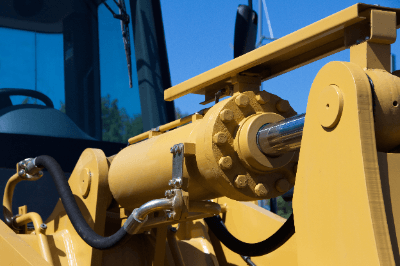What Is a Hydraulic Cylinder?

A hydraulic cylinder is an actuator that converts energy into mechanical motion. By controlling the amount of oil inside, the pressure is changed to control the motion of the piston.
Hydraulic cylinders come in single-acting and double-acting types, which differ in the number, position of valves, and internal geometry.
Hydraulic cylinder is used in various applications such as car brakes, elevators, and construction machinery because of their low noise and high output.
Uses of Hydraulic Cylinders
Hydraulic cylinders are used in many products because they can transform a small force into a large force. The most typical product used is a car brake system, where the small force of a foot push can generate a large force to stop the car. They are also used in elevators, construction equipment, and many other occasions where strong force is required, indicating their wide range of use. When making a selection, the pressure to be used, size, stroke width, and cycle should be taken into consideration.
Principle of Hydraulic Cylinders
Hydraulic cylinders contain a piston, and the piston is moved by injecting oil into the cylinder through a valve or by suctioning oil from the cylinder. The principle of operation of hydraulic cylinders varies depending on the position, number, and type of valves.
Single-acting hydraulic cylinders have one valve while double-acting hydraulic cylinders have two valves, which control piston movement by changing the pressure in the cylinder by changing the amount of operating oil. The piston is pushed out by reducing the oil in the valve on the bottom side to reduce the pressure or by increasing the oil in the valve on the opposite side to increase the pressure. When pulling the piston, the increase or decrease of the operating oil is reversed. In single-acting hydraulic cylinders, the piston is returned by its weight or a spring.
Types of Hydraulic Cylinders
As mentioned above, there are two types of hydraulic cylinders: single-acting and double-acting. Single-acting types are classified into ram type, piston type, double-rod type, and single-acting telescopic type. Double-acting types include piston, double-rod, double-cylinder, and telescopic types.
When selecting hydraulic cylinders, first clarify the required thrust and supply pressure and then determine the appropriate pressure receiving area. Increasing the pressure-receiving area of the cylinder or the pressure to be supplied will increase the output. In addition, what is used depends on the value of “nominal pressure,” which is the maximum value set pressure of the hydraulic cylinders. Typical examples include those for 7 MPa and 14 MPa. The most commonly used cylinder material is iron, but if a magnetic switch for stroke detection is installed, a stainless steel cylinder is used.
How to Use Hydraulic Cylinders
Hydraulic fluids used in hydraulic cylinders include petroleum-based, synthetic, and water-molded hydraulic fluids. Any of these hydraulic oils can be used, but it is advisable to check the specifications of each hydraulic cylinder when selecting one. It is recommended that the oil be filtered because the foreign matter in the hydraulic oil can interfere with regular operation.
To adjust the speed of the hydraulic cylinders, install a flow control valve in the hydraulic circuit to control the oil flow in the cylinder. In general, the amount of oil entering the cylinder is adjusted.
Also, when the hydraulic cylinders are operated, the air in the syringe must be purged. If the cylinder is pressurized with air in it, adiabatic compression will cause the air to become hot, which may cause seals to burn out.